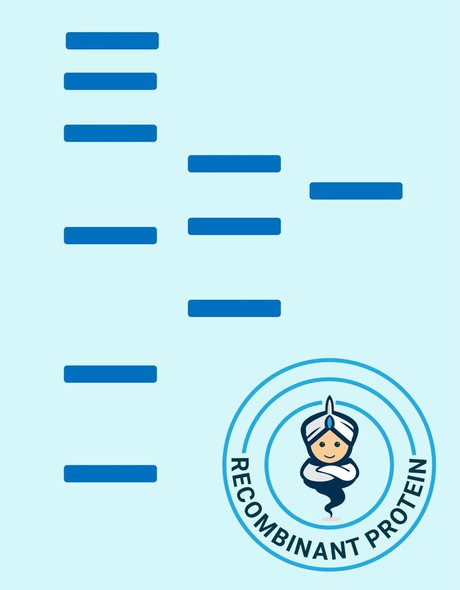Growth Factors & Cytokines Recombinant Proteins
Human OPG Recombinant Protein (RPPB0819)
- SKU:
- RPPB0819
- Product Type:
- Recombinant Protein
- Species:
- Human
- Uniprot:
- O00300
- Research Area:
- Growth Factors & Cytokines
Description
| Product Name: | Human OPG Recombinant Protein |
| Product Code: | RPPB0819 |
| Size: | 10µg |
| Species: | Human |
| Target: | OPG |
| Synonyms: | TNFRSF11B, OPG, OCIF, Osteoclastogenesis inhibitory factor, Osteoprotegerin, TR1, MGC29565. |
| Source: | Hi-5 cells |
| Physical Appearance: | Sterile Filtered colorless clear solution. |
| Formulation: | Osteoprotegerin protein contains PBS pH-7.4 and 10% glycerol. |
| Stability: | Store at 4°C if entire vial will be used within 2-4 weeks. Store, frozen at -20°C for longer periods of time. Please avoid freeze thaw cycles. |
| Purity: | Greater than 85.0% as determined by SDS-PAGE. |
| Amino Acid Sequence: | ADPETFPPKY LHYDEETSHQ LLCDKCPPGT YLKQHCTAKW KTVCAPCPDH YYTDSWHTSD ECLYCSPVCK ELQYVKQECN RTHNRVCECK EGRYLEIEFC LKHRSCPPGF GVVQAGTPER NTVCKRCPDG FFSNETSSKA PCRKHTNCSV FGLLLTQKGN ATHDNICSGN SESTQKCGID VTLCEEAFFR FAVPTKFTPNWLSVLVDNLP GTKVNAESVE RIKRQHSSQE QTFQLLKLWK HQNKDQDIVK KIIQDIDLCE NSVQRHIGHA NLTFEQLRSL MESLPGKKVG AEDIEKTIKACKPSDQILKL LSLWRIKNGD QDTLKGLMHA LKHSKTYHFP KTVTQSLKKT IRFLHSFTMY KLYQKLFLEM IGNQVQSVKI SCLSGRLVPR GSHHHHHH |
Osteoprotegerin acts as decoy receptor for rankl and thereby neutralizes its function in osteoclastogenesis. OPG inhibits the activation of osteoclasts and promotes osteoclast apoptosis in vitro. Bone homeostasis seems to depend on the local rankl/opg ratio. Osteoprotegerin may also play a role in preventing arterial calcification. May act as decoy receptor for trail and protect against apoptosis. Trail binding blocks the inhibition of osteoclastogenesis.
Recombinant Osteoprotegerin produced in baculovirus is a signle, glycosylated polypeptide chain containing 398 amino acid residues (22-401 a.a.), having a calculated molecular mass of 45.6 kDa. The Osteoprotegerin is fused to a 17 amino acid His tag at C-terminus and purified by proprietary chromatographic techniques.
| UniProt Protein Function: | TNFRSF11B: Acts as decoy receptor for RANKL and thereby neutralizes its function in osteoclastogenesis. Inhibits the activation of osteoclasts and promotes osteoclast apoptosis in vitro. Bone homeostasis seems to depend on the local RANKL/OPG ratio. May also play a role in preventing arterial calcification. May act as decoy receptor for TRAIL and protect against apoptosis. TRAIL binding blocks the inhibition of osteoclastogenesis. Defects in TNFRSF11B are the cause of juvenile Paget disease (JPD); also known as hyperostosis corticalis deformans juvenilis or hereditary hyperphosphatasia or chronic congenital idiopathic hyperphosphatasia. JPD is a rare autosomal recessive osteopathy that presents in infancy or early childhood. The disorder is characterized by rapidly remodeling woven bone, osteopenia, debilitating fractures, and deformities due to a markedly accelerated rate of bone remodeling throughout the skeleton. Approximately 40 cases of JPD have been reported worldwide. Unless it is treated with drugs that block osteoclast- mediated skeletal resorption, the disease can be fatal. |
| UniProt Protein Details: | Protein type:Secreted; Secreted, signal peptide; Inhibitor Chromosomal Location of Human Ortholog: 8q24 Cellular Component: proteinaceous extracellular matrix; extracellular space; extracellular region Molecular Function:cytokine activity; receptor activity Biological Process: response to drug; extracellular matrix organization and biogenesis; response to magnesium ion; negative regulation of odontogenesis of dentine-containing teeth; response to estrogen stimulus; apoptosis; response to arsenic; negative regulation of bone resorption; signal transduction; skeletal development; response to nutrient Disease: Paget Disease, Juvenile |
| NCBI Summary: | The protein encoded by this gene is a member of the TNF-receptor superfamily. This protein is an osteoblast-secreted decoy receptor that functions as a negative regulator of bone resorption. This protein specifically binds to its ligand, osteoprotegerin ligand, both of which are key extracellular regulators of osteoclast development. Studies of the mouse counterpart also suggest that this protein and its ligand play a role in lymph-node organogenesis and vascular calcification. Alternatively spliced transcript variants of this gene have been reported, but their full length nature has not been determined. [provided by RefSeq, Jul 2008] |
| UniProt Code: | O00300 |
| NCBI GenInfo Identifier: | 322510101 |
| NCBI Gene ID: | 4982 |
| NCBI Accession: | O00300.3 |
| UniProt Secondary Accession: | O00300,O60236, Q53FX6, Q9UHP4, B2R9A8, |
| UniProt Related Accession: | O00300 |
| Molecular Weight: | 46,026 Da |
| NCBI Full Name: | Tumor necrosis factor receptor superfamily member 11B |
| NCBI Synonym Full Names: | tumor necrosis factor receptor superfamily, member 11b |
| NCBI Official Symbol: | TNFRSF11B�� |
| NCBI Official Synonym Symbols: | OPG; TR1; OCIF�� |
| NCBI Protein Information: | tumor necrosis factor receptor superfamily member 11B; osteoprotegerin; osteoclastogenesis inhibitory factor |
| UniProt Protein Name: | Tumor necrosis factor receptor superfamily member 11B |
| UniProt Synonym Protein Names: | Osteoclastogenesis inhibitory factor; Osteoprotegerin |
| UniProt Gene Name: | TNFRSF11B�� |
| UniProt Entry Name: | TR11B_HUMAN |






